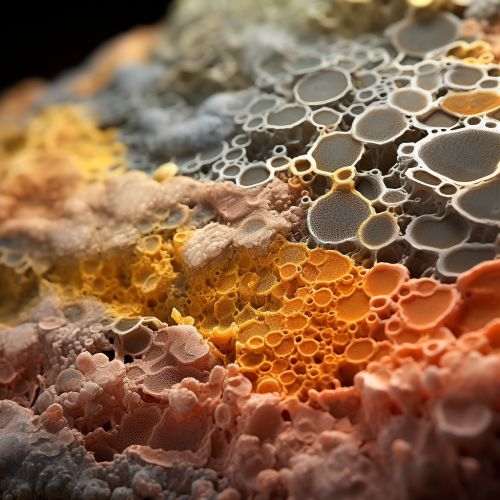Biofilm
Introduction
Biofilms are complex, self-organized consortia of microorganisms that grow on a variety of surfaces, including natural environments, human bodies, and industrial settings. These microbial communities are characterized by cells that are embedded in a matrix of extracellular polymeric substances (EPS) that they have produced. The EPS, composed primarily of polysaccharides, proteins, and nucleic acids, provides a protective environment for the biofilm community and aids in adhesion to surfaces. Biofilms represent a predominant form of growth for microorganisms and are of significant importance due to their impact on human health, industry, and the environment more on biofilm formation.
Biofilm Structure
Biofilms are not just simple clumps of cells. They have a complex, heterogeneous architecture that includes mushroom-shaped microcolonies, water channels for nutrient and waste transport, and a protective exopolysaccharide matrix. The biofilm structure allows for a division of labor among the microbial community, with different microorganisms performing different tasks, such as nutrient acquisition, waste removal, and defense against predators or antimicrobials more on microbial ecology.


Biofilm Formation
Biofilm formation is a dynamic process that involves several stages. It begins with the initial attachment of planktonic (free-floating) cells to a surface. These cells then multiply and produce EPS, forming a microcolony. As the biofilm grows, it develops a complex, three-dimensional structure through a process known as maturation. Finally, some cells detach from the biofilm and return to the planktonic state, potentially colonizing new surfaces. This cycle of attachment, growth, maturation, and detachment is influenced by various environmental factors, such as nutrient availability, temperature, and pH, as well as by the characteristics of the microbial species involved more on microbial physiology.
Biofilm and Human Health
Biofilms have a significant impact on human health. They are involved in a wide range of infections, including chronic wounds, lung infections in cystic fibrosis patients, and infections associated with medical devices such as catheters and implants. Biofilms are particularly problematic in healthcare settings because they are often resistant to both antimicrobial agents and the host immune response. This resistance is due to several factors, including the protective EPS matrix, the slow growth rate of biofilm cells, and the presence of 'persister' cells that are tolerant to antibiotics more on antimicrobial resistance.
Biofilm in Industry and Environment
Biofilms also have important implications in industry and the environment. In industrial settings, biofilms can cause problems such as biofouling of pipes and equipment, leading to decreased efficiency and increased maintenance costs. On the other hand, biofilms can also be beneficial in certain applications, such as wastewater treatment and bioremediation, where they can help break down pollutants. In the environment, biofilms play key roles in nutrient cycling and the maintenance of biodiversity more on environmental microbiology.
Biofilm Research and Future Directions
Research on biofilms has greatly expanded our understanding of microbial life. This research is multidisciplinary, involving fields such as microbiology, molecular biology, chemistry, physics, and engineering. Current research focuses on understanding the mechanisms of biofilm formation and resistance, developing new methods for biofilm detection and removal, and exploring the use of biofilms in biotechnology. As our knowledge of biofilms continues to grow, it is likely that new strategies for managing biofilms in healthcare, industry, and the environment will be developed more on microbial biotechnology.
